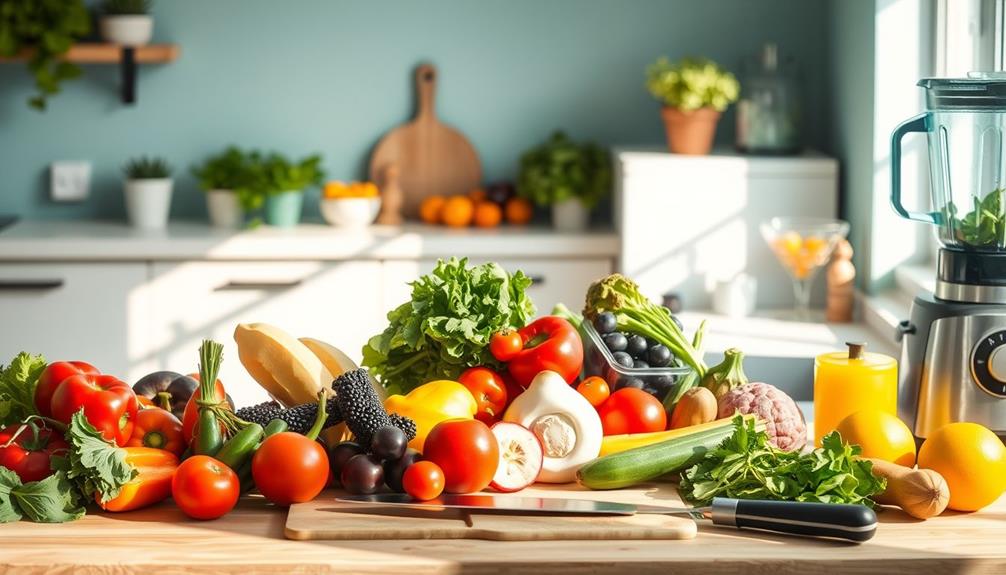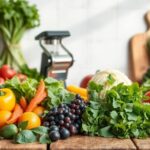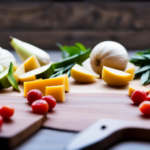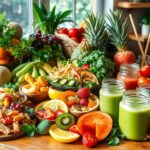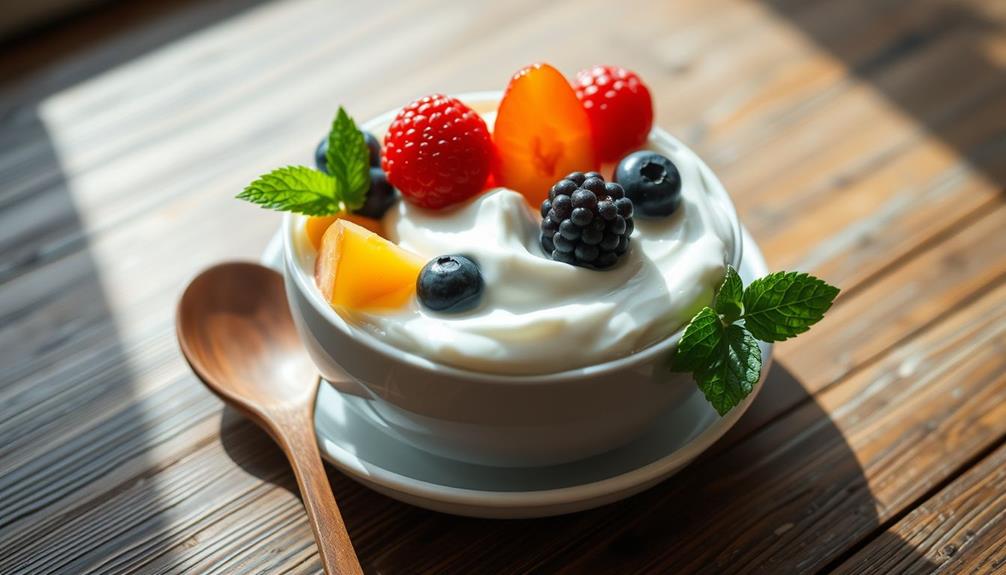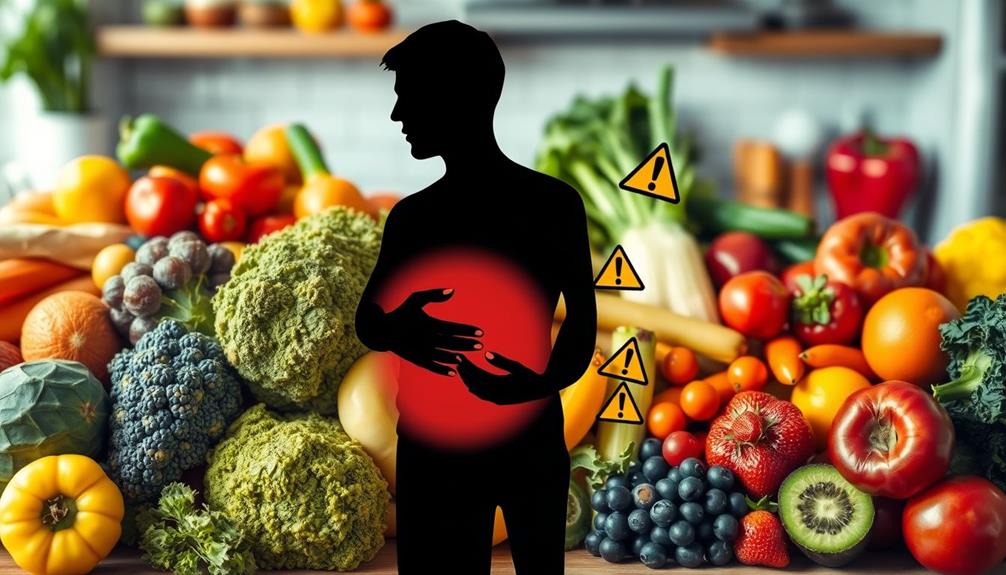To prepare raw food successfully, start by sourcing fresh, seasonal ingredients from local markets. Focus on techniques like soaking, sprouting, and massaging greens with oil and salt to enhance flavor and digestibility. Equip yourself with essential tools like a high-quality blender and dehydrator for easy preparation. Planning your meals weekly can keep your nutrition balanced and reduce stress. Experiment with herbs, spices, and healthy dressings to amp up flavors. Don't forget to address common nutritional concerns like deficiencies in vitamin B12. Keep exploring for more creative ideas and techniques to elevate your raw food experience.
Key Takeaways
- Emphasize uncooked, unprocessed ingredients to retain nutrients, ensuring food is kept below 118°F during preparation.
- Utilize techniques like soaking, sprouting, and massaging greens to enhance digestibility and flavor.
- Source fresh, seasonal, and organic produce from local farmers markets to maximize flavor and nutrition.
- Plan weekly menus and batch prepare ingredients to streamline cooking and ensure balanced nutrition.
- Experiment with flavor-enhancing techniques, including using acidic elements and herbs, to elevate raw food dishes.
Understanding Raw Food Basics
Understanding the basics of raw food can transform your approach to eating and cooking. Raw food diets emphasize the consumption of uncooked, unprocessed foods to retain fundamental nutrients and enzymes. Keeping food below 118°F is essential for preserving these critical components, so managing temperature during food preparation is key. Incorporating fresh ingredients like celery juice benefits can enhance your raw meals with added antioxidants and hydration.
To elevate your raw meals, employ techniques like soaking, sprouting, dehydrating, and blending. These methods not only enhance digestibility and flavor but also help maintain nutritional integrity. Incorporating a variety of seasonal ingredients can further enrich your dishes, ensuring you get a diverse range of nutrients and flavors that support your overall health.
Don't overlook the importance of leafy greens in your raw food repertoire. Massaging them with oil and salt for at least five minutes breaks down their fibers, making them easier to digest and more flavorful.
To make your raw food preparation seamless and enjoyable, invest in essential tools like a high-quality blender or dehydrator. With these basics in mind, you'll be well on your way to creating delicious and healthful raw meals that nourish your body and satisfy your palate.
Sourcing Fresh Ingredients
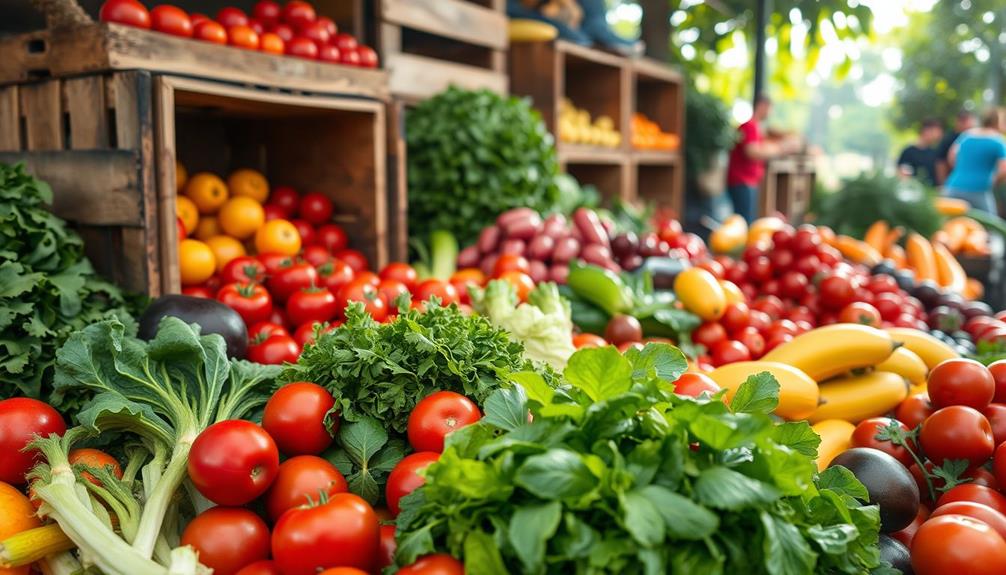
When you're sourcing fresh ingredients for raw food, farmers markets are a goldmine for seasonal produce.
You'll find organic options that not only enhance your dishes but also spark creativity with their vibrant flavors.
Additionally, exploring local markets can lead you to discover unique items that align with the current trends in the food industry, such as the rise of AI-driven solutions in healthcare.
Connecting with local farmers can help you discover which veggies are best for raw consumption and how to pick the freshest ones.
Farmers Markets Benefits
Farmers markets offer a treasure trove of fresh, seasonal produce that can greatly elevate the flavor and nutritional value of your raw food dishes. By sourcing your ingredients from these markets, you guarantee that you're working with the best seasonal ingredients available.
Engaging directly with local farmers not only provides you with high-quality produce but also the knowledge about how to best prepare various vegetables for raw consumption. Additionally, you might find unique and wicked planters to enhance your kitchen garden, which can help showcase your fresh finds in a stylish way unique planter designs.
At farmers markets, you can often find organic options, which align perfectly with the principles of a raw food diet by keeping your meals free from harmful pesticides and chemicals.
Additionally, purchasing from these markets supports sustainable agriculture, helping to reduce the carbon footprint associated with transporting food long distances.
Exploring the variety of fruits and vegetables available can inspire creativity in your raw food preparation, allowing you to diversify your meals. With each visit, you'll discover new flavors and textures that can transform your dishes.
Seasonal Ingredient Inspiration
Sourcing seasonal ingredients can transform your raw food dishes into vibrant culinary experiences. When you visit farmers markets, you'll discover a treasure trove of fresh, seasonal produce that elevates both the flavor and nutritional value of your raw foods. Engaging directly with farmers not only allows you to find the freshest ingredients, but it also gives you valuable insights into which vegetables are raw edible. This knowledge helps you make informed choices for your recipes.
Additionally, exploring the unique coffee varieties available can inspire your palate and enhance your raw food creations, encouraging a delightful fusion of flavors.
Incorporating seasonal ingredients into your meals inspires creativity and encourages you to experiment with a variety of flavors and textures. By planning your raw food menu around what's in season, you guarantee that you're using the freshest ingredients available. These seasonal gems are often tastier and more nutrient-dense than out-of-season options.
Moreover, sourcing local ingredients supports local agriculture and minimizes your environmental impact. So, don't hesitate to explore new vegetables that are currently in season. You'll be amazed at how these fresh finds can enhance your raw meals, making them not just healthier, but also more exciting to prepare and enjoy.
Essential Preparation Techniques
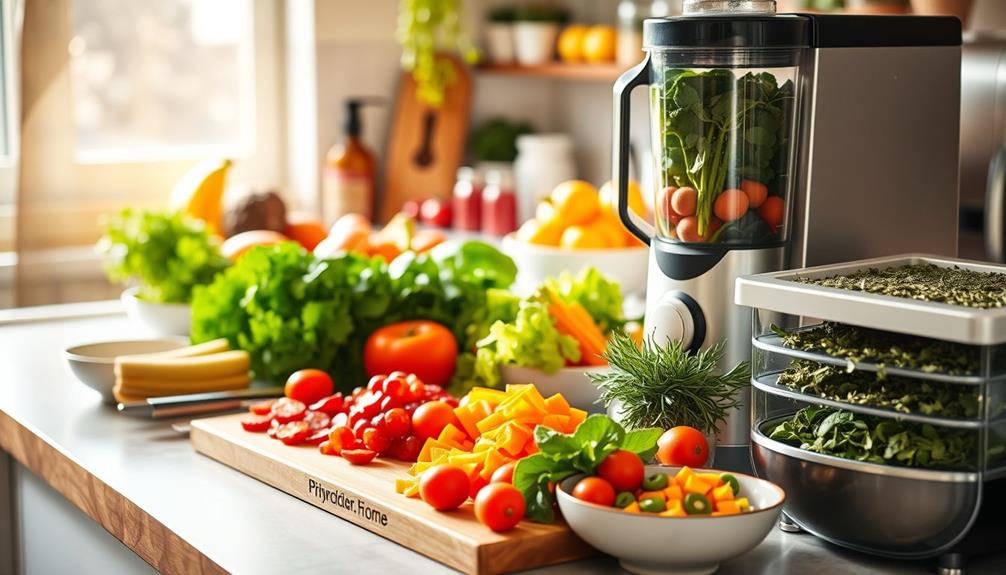
When preparing raw food, effective time management can make all the difference in your kitchen workflow.
Incorporating a variety of fresh ingredients can enhance nutrient absorption and promote overall health, as raw foods are known for their high vitamin and antioxidant levels boosts immune system function.
You'll also want to sharpen your knife skills, as they're essential for achieving uniform cuts and enhancing presentation.
Together, these techniques set the foundation for a successful raw food experience.
Time Management Strategies
Effective time management is essential for anyone embracing a raw food lifestyle. To streamline your raw food preparation, plan ahead for non-active tasks. Soaking seeds, nuts, and grains overnight not only enhances digestion but also frees up your time during the day.
Additionally, maintaining a clean kitchen environment can improve efficiency, similar to how air purifier maintenance dos and don'ts guarantee a healthier home.
Preparing ingredients in bulk is another smart strategy. Chop vegetables and make dressings in advance to save significant time throughout the week, guaranteeing quick options are always available.
Utilizing kitchen appliances like a Vitamix blender or dehydrator can further accelerate your meal prep, allowing for quicker assembly and a variety of textures in your dishes.
Set aside dedicated time each week for meal prep. This practice maintains consistency and reduces the daily cooking stress, making it easier for you to stick to a raw food diet.
Finally, make your kitchen time enjoyable by listening to podcasts or music while you prep. This not only enhances your efficiency but also makes the process more pleasant.
Knife Skills Importance
Mastering knife skills is crucial for anyone diving into raw food preparation. Good knife techniques not only elevate the presentation and texture of your ingredients but also guarantee safety and efficiency in the kitchen.
Utilizing your knife skills can also enhance your experience with fresh ingredients, similar to how essential oils can provide therapeutic benefits in cooking. Here are four key aspects to focus on:
- Choose the Right Knife: Use chef's knives for general chopping, paring knives for peeling, and serrated knives for bread or delicate fruits. Each knife serves a specific purpose, enhancing your cutting techniques.
- Practice Proper Grip: Employ the claw grip and rocking motion to maintain control and minimize accidents. This technique keeps your fingers safe while optimizing your cutting speed.
- Hone Your Blades: Regularly honing your knife blades is crucial. Sharp knives yield cleaner cuts, preserving the integrity and freshness of your raw ingredients.
- Master Consistent Cuts: Focus on uniform dicing and julienning. These consistent cutting techniques not only look appealing but also promote even marination and flavor absorption in your dishes.
Enhancing Flavor and Texture
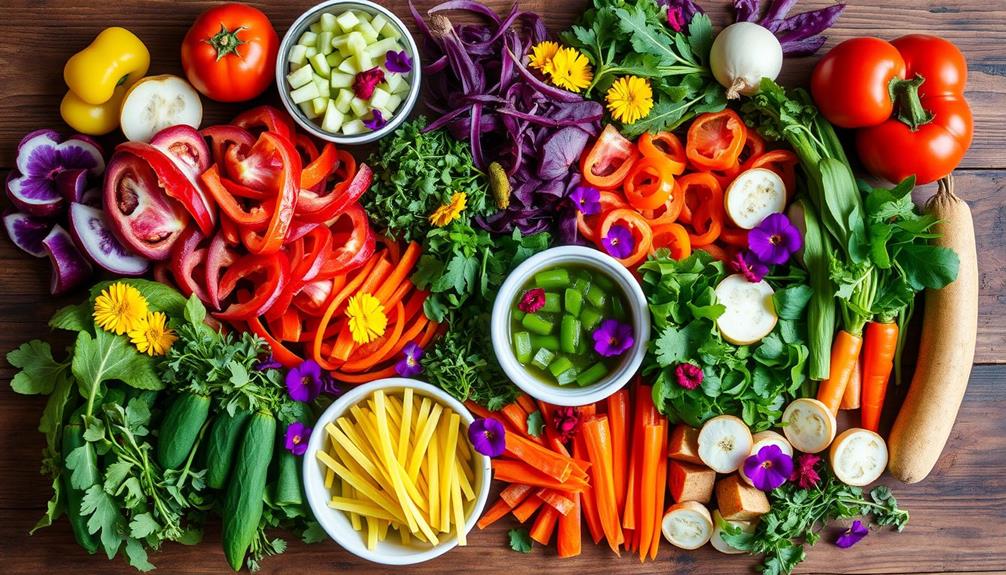
Enhancing the flavor and texture of raw food can transform your meals into vibrant culinary experiences. One effective method is massaging greens with olive oil and salt for at least five minutes. This simple preparation method breaks down their fibers, making them more digestible while enhancing flavor.
Additionally, incorporating various brewing methods can inspire unique flavors in raw food dishes, just as they do in coffee preparation.
Don't forget the power of acidic elements like lemon juice or vinegar. Adding these to vegetables not only boosts their taste but also tenderizes them, creating a delightful contrast in textures. For even better results, prepare your dressings in advance, allowing the acid to fully penetrate the vegetables before serving.
Incorporating cashew cream into your dishes offers a rich, dairy-free alternative that adds creaminess and depth of flavor, perfect for those looking to elevate their raw cuisine.
Finally, don't shy away from experimenting with a variety of herbs and spices. They can greatly amplify the taste profile of your raw dishes, making them more appealing and flavorful.
Must-Have Tools and Appliances
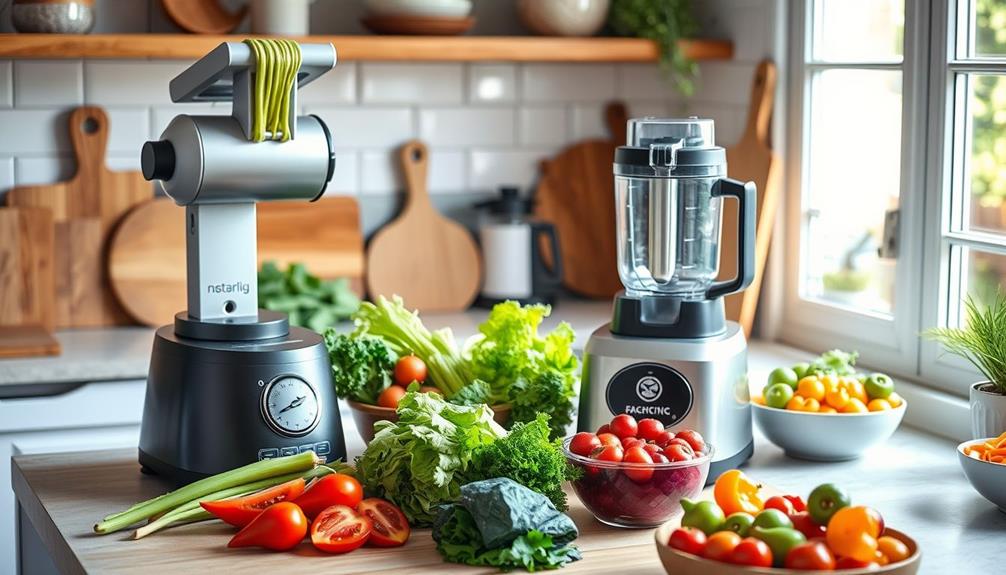
To create delicious raw meals, having the right tools and appliances on hand makes all the difference. Investing in these essential items won't only enhance your culinary experience but also streamline your preparation process.
Additionally, understanding the nutritional benefits of your ingredients can further elevate your dishes, especially when considering food beneficial for managing gout symptoms.
Here are four must-have tools for your raw food kitchen:
- Vitamix: This powerful blender is a game-changer for making smoothies, soups, and sauces effortlessly. Its versatility makes it a staple in raw food preparation.
- Food Processors: A quality food processor can handle chopping, slicing, and mixing raw ingredients quickly. This appliance saves time and guarantees even consistency in your dishes.
- Dehydrators: If you're looking to create crispy textures and intensify flavors in your meals, a dehydrator is essential. You can find cost-effective models for under $50 that will elevate your raw food game.
- Spiralizers: Add a fun twist to your meals by transforming vegetables like zucchini into noodle shapes. Spiralizers bring creativity and variety to your raw dishes.
With these tools, you'll be well-equipped to prepare a range of delicious and satisfying raw meals.
Meal Planning Strategies
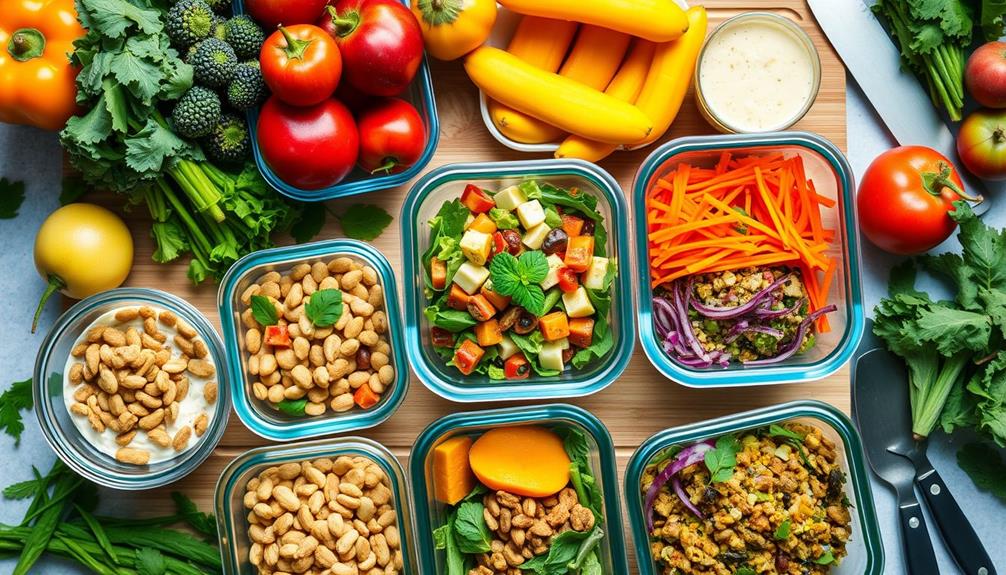
Effective meal planning is key to enjoying the benefits of a raw food diet without feeling overwhelmed. Start by creating a weekly menu that includes a variety of raw fruits, vegetables, nuts, and seeds, ensuring balanced nutrition and helping prevent dietary fatigue while following a vegan diet.
Incorporating proper diet guidelines can also enhance your meal choices and overall health. Plan ahead by soaking seeds, nuts, and grains overnight. This not only aids digestion but also makes meal prep more efficient. Engage with seasonal produce from local farmers markets to inspire creativity and enhance the flavors in your dishes.
Allocating specific time blocks for meal prep can help manage your time effectively. This way, you won't feel stressed by the labor-intensive nature of raw food preparation.
Consider using non-active tasks, like soaking or sprouting, to multitask. You can listen to podcasts or music while you work, making the experience more enjoyable.
Nutritional Considerations
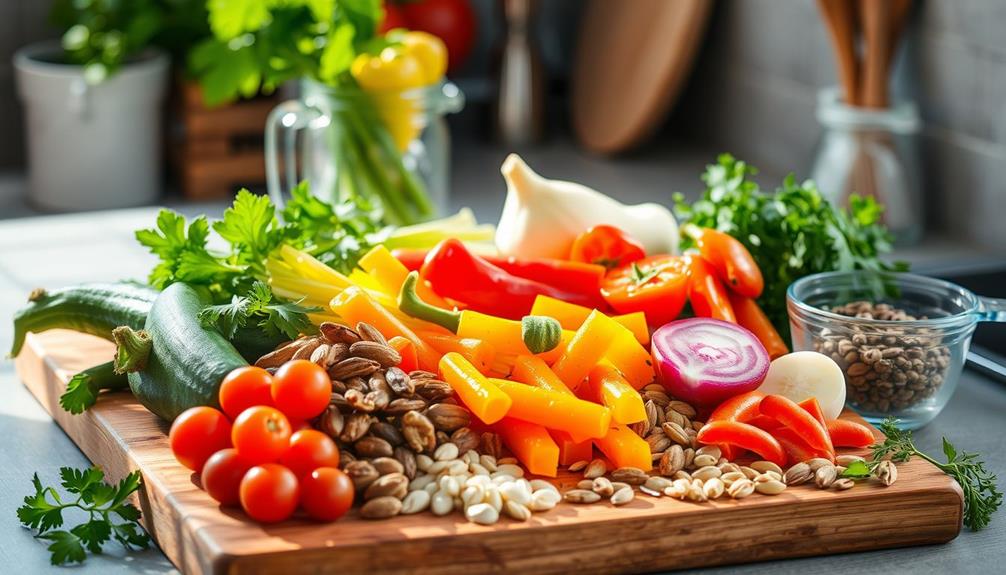
When starting on a raw food diet, it's essential to pay close attention to nutritional considerations. While raw foodists enjoy a wealth of vitamins and minerals from fruits and vegetables, this diet can lead to nutritional deficiencies if not properly managed.
Key nutrients like vitamin B12, iron, and omega-3 fatty acids may fall short, so careful planning and supplementation might be necessary.
To guarantee a balanced nutrient profile, consider these tips:
- Diversify Your Sources: Include a variety of plant-based foods to cover a broader spectrum of nutrients.
- Pair for Absorption: Combine iron-rich foods like leafy greens with vitamin C-rich fruits to enhance iron absorption.
- Watch Your Macronutrients: Balance your intake of fruits, vegetables, nuts, and seeds to avoid excessive sugar and energy fluctuations.
- Consider Supplementation: If you're at risk for nutritional deficiencies, especially in vitamin B12, consult with a healthcare professional about appropriate supplements.
Common Challenges and Solutions
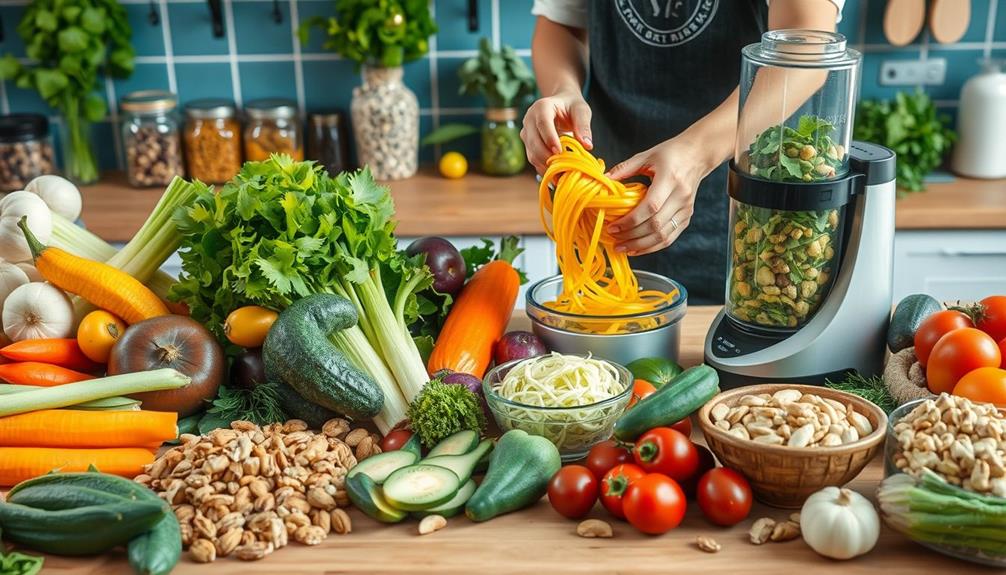
Shifting to a raw food diet can present several challenges, but understanding these hurdles makes it easier to find effective solutions.
One common issue is the time-consuming nature of meal preparation. To combat this, plan ahead and dedicate specific days for batch processing your ingredients. This can streamline your cooking and reduce daily prep time.
Another challenge is digestive discomfort, which many people experience when altering to raw veganism. To ease this, gradually incorporate raw foods into your meals, allowing your body to adjust slowly.
Dining out can also pose difficulties due to limited food options; research restaurants with raw or vegan-friendly menus in advance to avoid frustration.
Additionally, nutrient deficiencies, particularly in vitamin B12, can arise from a strict raw food diet. Consider supplementation or include fortified foods to maintain adequate nutrient intake.
Finally, variety is key to preventing dietary monotony. Keep your meals exciting by experimenting with seasonal ingredients and new recipes.
Creative Recipe Ideas
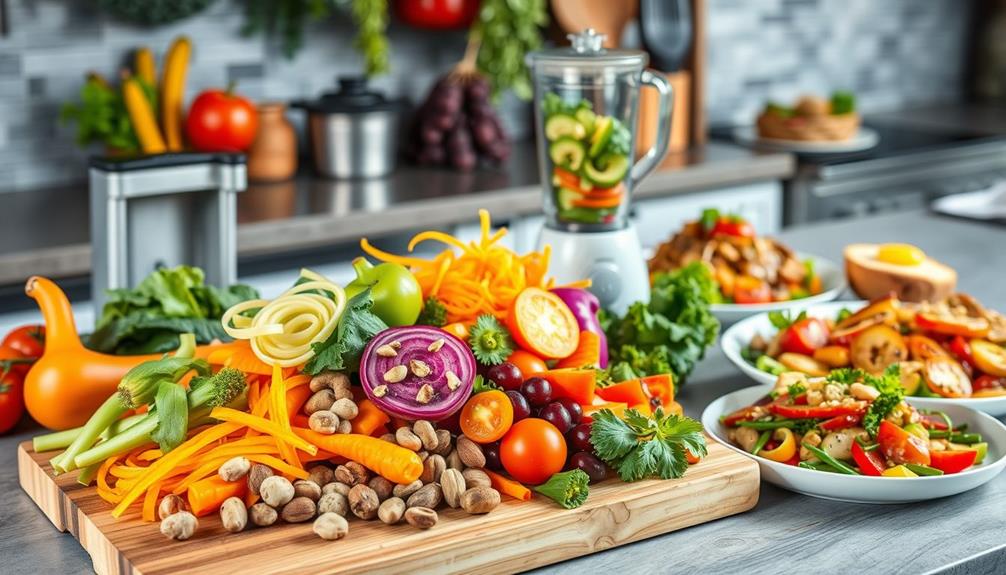
Exploring the world of raw food can be an exciting culinary adventure, filled with vibrant flavors and fresh ingredients.
As you immerse yourself in vegan cooking, you'll discover numerous creative recipe ideas that celebrate the goodness of raw fruits and vegetables.
Here are four delicious options to get you started:
- Zucchini Noodles: Use spiralized zucchini as a gluten-free pasta alternative. Top it with a raw tomato sauce made from blended fresh tomatoes, garlic, and basil for a revitalizing dish.
- Raw Energy Bars: Blend dates, nuts, and seeds together, then press the mixture into a pan. Refrigerate until firm and enjoy a nutritious snack on the go.
- Vibrant Kale Salad: Massage chopped kale with olive oil and lemon juice. This technique tenderizes the greens and enhances their flavor for a delightful salad.
- Colorful Vegetable Platter: Arrange a variety of raw veggies like bell peppers, cucumbers, and carrots. Serve with a cashew cream dip for a satisfying appetizer.
These creative recipe ideas won't only nourish your body but also keep your meals exciting and fresh!
Frequently Asked Questions
What Are the Techniques of Raw Food?
You can explore various techniques of raw food preparation, like soaking, dehydrating, sprouting, blending, juicing, and fermenting. Each method enhances flavors, improves digestibility, and maximizes nutrients, making your meals both delicious and nutritious. To get started with experimenting with these raw food cooking techniques, you can try simple recipes like overnight chia pudding, zucchini noodles with raw marinara sauce, or a refreshing green smoothie. As you become more familiar with these techniques, you can start incorporating them into more complex dishes and even create your own unique raw food recipes. With a bit of creativity and experimentation, you’ll soon find that raw food preparation can be both fun and rewarding.
How Do You Prepare Raw Food?
When you prepare raw food, you're not just chopping; you're creating vibrant, nourishing meals. Soak nuts overnight, massage greens, and blend your ingredients. Planning ahead makes the process enjoyable and enhances the flavors you'll savor.
How Do You Make Raw Food Safe?
To make raw food safe, you should wash all fruits and vegetables thoroughly, soak nuts and seeds overnight, use separate utensils to avoid cross-contamination, and store items in the fridge below 40°F for freshness.
How to Get Started on a Raw Food Diet?
To get started on a raw food diet, you'll want to gradually add raw meals, invest in essential tools, focus on fresh produce, plan meals ahead, and connect with supportive communities for inspiration and motivation.
Conclusion
In the vibrant world of raw food, you're not just eating; you're starting on an epic culinary adventure! With fresh ingredients bursting with life, your meals can transform into dazzling masterpieces. You'll slice, dice, and blend your way to health, flavor, and unparalleled creativity. Don't let challenges stand in your way; you've got the tools and techniques to conquer anything! So immerse yourself, and watch your kitchen become a paradise of raw delights that'll leave everyone in awe!

